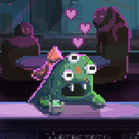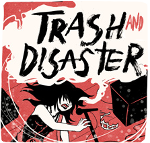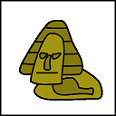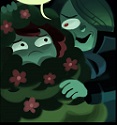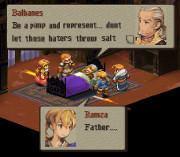|
Vodvillain posted:I've taken a look at a bunch of dungeon crawlers (because it's definitely not a genre that's been done to death) but just about all the ones I've seen are about building up one character to work solo or in a party of other players. Are there games out there that have you command a party of heroes through a dungeon similar to what I was thinking? I'd like to see what's out there for inspiration on what works and what doesn't. Any general advise related to this type of game would also be greatly appreciated. What games would be recommended here? I've had an occasional daydream about a "Cave Exploration" boardgame that I could sell at the NSS convention. Something along the lines of accumulating prestige/surveying faster than the other players but needing to have enough other players join in each expedition for it to succeed.
|
|
|
|

|
| # ? May 13, 2024 18:22 |
|
The Cave is like that (except the joining in part). Might want to check it out and see what it does and how, might turn on some light bulbs for you or highlight what you want to do differently.
|
|
|
|
I did another solo test of my Betrayal rework, this time with me running three different pawns who I decided were all trying to cooperate with one another. It made me a realize a few important things. One, is that grid based movement isn't fun or interesting. Even with a market row on room tiles, there wasn't enough interesting choices, and a lot of the bad rooms just stayed in the entire time while players cycled through beneficial / neutral rooms. It was hard, but I've decided to change that whole part of the game. There are now three different market rows of room cards (which are 5x8 index cards instead of 2x2 squares that players use an almanac to reference). The top and bottom floors give 3 cards face up, and the main floor gives 5. Players may freely encounter any room on a floor that they are in, although they only have three cards of their eventual six card hand to make the decision. So they encounter a room, pull an event (now called anomalies) if necessary, and then draw up to 6 cards and attempt the check. In order to move between floors, they simply have to pass a check of any three cards of the same color with total value of 5 (for reference this is slightly harder than a starting deck can handle). They may discard a room card from the current market row that they are in, but doing so generates 1 Dread. Certain fixed rooms that are necessary to the game (e.g. the Boiler Room) are now pre-seeded into the deck, and when they come up they are moved out of the market row to the side, with an additional card coming up to replace them. Therefore, there's still the exploration element to the game (like, the Death archetype still has to do some work to get the boiler room up), but not exactly the same thing. Otherwise, roughly 2/3rds of the room deck will be used for a single game, with the remainder being remove from the game. Keys (instead of being pre-seeded into the object deck) are now tied to certain fixed event rooms. Before I had the problem where I hadn't properly balanced the ratio of object deck rewards (allowing players to draw to the keys) to other rewards. This fixes that problem, and tells players "you need to explore rooms to win", while making balancing rewards simpler. Apart from changing movement, I also realized that events (now anomalies) and rooms were way too similar. There wasn't a clear distinction between the two, and everything the players did sort of blended together. So, instead, rooms are now the ONLY thing in the game that forces checks. Anomalies now MODIFY everything that exists on a room card, but don't do anything else. For reference, here's my mock-up of a room card for the current version:  I haven't redesigned anomalies yet, but the basic idea is that they will focus on modifying one or several of the following areas: > Check value. The only cards that draw anomalies have a check of some sort to avoid confusion. > Additional rules. Fun stuff, like shifting the board around, or revealing archetypes, or giving choices depending on the current level of dread, or providing power moves for people looking to activate their archetype. I'm going to try to make sure that all of the "fun stuff" is reserved for anomalies, and the rooms are fairly basic. > Better rewards, more costly failures. The consequences of both changes is that now pretty much everything I designed for the first stage of the game is obsolete, so now I have to go back through and redo them. I have a slight problem now, however. Orange cards no longer really serve a purpose, and it seems better to have three main resource types instead of four. However, four resource types was symmetrical (two focused on the brain and cleverness, two focuses on athleticism and strength). I've also made a change to the rules where any Fatigue or Delirium damage may be negated by instead trashing an appropriate character card (red and orange for fatigue, blue and green for delirium). I'm thinking I can keep that in play, but now it's: trash blue to avoid delirium, trash red to avoid fatigue, trash green to avoid dread. I'm also considering a major change where instead of gaining damage as tokens, players instead take on junk cards to represent damage, but I'm not sure if that's a good idea or not. I'm going to leave it as tokens for the time being, and do another playtest with that in mind after I rework all of the game assets. sector_corrector fucked around with this message at 19:23 on Jun 28, 2016 |
|
|
|
Hi thread, I'm working on a little lego game mostly just for me and my friends but who knows who else might want to play it. It's not really a "lego game", I just use a lot of lego as tokens and the game board as it's a bunch of handy pre-made pieces and boards. At the core of the game it's an economic strategy game about collecting raw materials and converting them into more complex and refined items. 15 years ago when we last played this game the economy was quite simple. Maps were just lego baseplates with randomly generated resource deposits scatteredThere were only 2 raw materials, Ore and Rare. Plop a mine on top of an ore or rare deposit and you get one of those resources each turn. Build a factory and you can convert either one ore into machinery, or one rare into electronics. You can build a "tritanium mill" that lets you combine ore (red) and Rare (blue) into Tritanium (purple) which counts as 3 ore when used in construction, and is required for more advanced upgrades. Very simple economy but it worked and supported the rest of the gameplay (spaceships!). The problem in my mind though is that with there only being 2 raw materials, every player was mostly self sufficient and there was almost never any trading. Everyone would in parallel build their own self-sufficient economies. I want to encourage trade, and I want the production chains a little more complex so it's harder or even inefficient to try to be self-sufficient. I originally wanted food to be a resource, but it ended up never being interesting, you'd just always build 1 food producing thing for every population unit you had and that was that, why not bake abstracted farming into the price of each city and keep it simple. I also thought about energy, but it was the same situation. You can't really stockpile energy very well, so you either have enough or you don't, so just assume every time you build a mine or a factory or whatever that you're also building whatever power generation is needed as well. So, I want to add a bit more complexity to the game, have one or two more raw resources to have more reason to trade, and allow more complex production chains. There's also the physical limit of lego colours and shapes I have to represent things, and the 6 colours of risk tokens we used as resources (never used green). I just ordered a ton of chinese plastic gems in various colours to use for potential new resources. I'll have gems in Red, Blue, Green, Black, and Silver. I was thinking the gem-form could be like the raw form of these resources which need to be processed into their matching colour, but that's just adding more processing steps, not more variety. Just looking for some ideas and some people to bounce ideas off of that might have more experience in more economic games. Short of Catan I haven't really played many games that involved resources, and this initial economy system was actually based off an extremely simplified version of the Emperor of the Fading suns economy. 
|
|
|
|
Baronjutter posted:Hi thread, I'm working on a little lego game mostly just for me and my friends but who knows who else might want to play it. It's not really a "lego game", I just use a lot of lego as tokens and the game board as it's a bunch of handy pre-made pieces and boards. Not a boardgame, but M.U.L.E. is my recommended go-to for this kind of cooperative-competitive economy game. What you really need is specialization of labor/economies of scale. 4 ore mines and 4 rare mines split evenly between two players should be less productive than a player with 4 ore mines and a player with 4 rare mines. You need to reward players for deviating from self-sufficient builds or else they'll always stick with self-sufficiency. Alternately, you can enforce specialization through unequal resource access; if different resources are available on different parts of the map and there's a limit to players' geographic reach, they're no longer going to be able to get everything they need. Or have resources (including spots for factories) vary by quality, so the number of really good deposits of each type is smaller than the number of players and they have to either cooperate or suck it up and limp along with lower resource production.
|
|
|
|
Yeah one thing I was thinking of is specialization and technology. Do you research level 3 factories or level 2 mines, and farming? Access to deposits is easy as they are randomly scattered on the map. With only 2 types though everyone's probably going to get at least one of both though, but with 4? Here's an expanded tree. I drew some inspiration from the anno series, the king of ridiculous confusing production chains. What I wanted though was every raw resource to be used a variety of times, so you'd have to make choices.  Agriculture is of course food, but also anything grown, so textiles, and precursors for bio-plastics, biofuels and such. Every unit of population needs a unit of agriculture each turn. Materials is a sort of catch all generic resource. It's concrete, it's timber, it's ceramics, it's limestone, it's fiberglass, it's generic stuff generally used as a construction material in most building costs. Metal is your iron, your steel, titanium, aluminum, it's stuff you make buildings, vehicles, and heavy equipment out of. Most buildings, units, and ships all require metal somewhere in their cost. Rare Earth represents of course rare earth metals, all those generally hard to get but extremely useful resources mostly used in high-end electronics. I don't think anything uses Rare directly, but it's very important for making more advanced resources. Those are the 4 raw materials, up from 2, so we're already nearly at catan levels of raw resources. There's also money too, so that's almost 5. Certainly 5 base things to trade. Chemicals Would be a new resource I'm not 100% sure the uses for within the system. I could make it an ingredient for tritanium too. In my mind it represents plastics, lubricants, and various industrial chemicals. Machinery is pretty self explanatory. It's heavy industrial equipment, it's appliances. Most industrial buildings cost a lot of machinery to build. Electronics is once again fairly self explanatory. It's everything from consumer electronics to industrial control computers to missile guidance systems. It's obviously used in a lot of building and unit recipies. Tritainium is your standard scify super metal. It can be used in place of Metal in recipes where it's worth double or triple (depending on game balance) and military units build with it have more HP/Armour. Robotics is another new resource, I imagine it would be used in a lot of higher-end building recipes. How the game works is that each city is a stack of 2x2 white blocks with each block representing a population unit. Each population unit in a city can work one district. Districts are: Farm: Produces X units of agriculture per turn Mine: Produces X units of what ever resource deposit its built over (metal, material, rare) Chemical Plant: Can convert 1 agriculture and 1 materials into 1 chemicals Industrial District: Can convert 1 metal and 1 materials into 1 machinery Electronics Plant: Can convert 1 rare and 1 materials into 1 electronics Tritanium Mill: Can convert 1 metal and 1 rare into 1 tritanium Robot Factory: Can convert 1 machinery and 1 electronics into 1 robotics All buildings can level up, requiring technology and more and more expensive recipes. The advantage of leveling up rather than just building more is that you don't need more population to run them. For mines you have to keep up with technology because there will be mechanics that randomly hit deposits with permanent stacking -1 production modifiers (the game is a bit of a space race to get off world before resources run out and the environment goes to poo poo) In the last version of the game money was generated by selling your resources back into your economy, representing the taxes you were generating from essentially keeping those resources in the private sphere and being used by your population. Every resource had a fixed sell price, and more advanced resources would always sell more than the sum of their parts. This worked fairly well and was balanced so that you were always short on everything rather than a single bottleneck forming in every game. The problem is, your society didn't really need any resources to function. You built a building and it would just produce. Your people were just as happy enjoying a mix or resources or suddenly getting 20 units of machinery dropped on them. I want to some how model that your society, as it grows, also requires more resources to keep happy and productive and that they want a mix of things. At the same time I don't want micromanagement hell, the game was always very simple so could flow quickly. Nothing ever needed to be written down, it was generally just a matter of looking at the map, seeing you have 5 red blocks and grabbing 5 red resources which you know you can feed into your 3 black blocks to get 3 black resources. Simple. But it didn't really represent a consumer market at all, and there were no upkeep costs for anything so players would simply grow exponentially, only their horrific military losses slowing them down. But what of the civilian economy? I want there to be some punishment for not providing for your empire, and some reward for providing a balanced mix of goods. I want it to be simple, nothing ridiculous like fractional resources. I also want it elastic beyond food. In the anno series you had to feed more and more advanced resources to your population in order for them to level up, but I don't have any sort of "level" based system for population representing class or wealth or happiness. One thought would be a country-wide HDI sort of stat representing how educated, happy, and materially well off your people are, mostly based on supplying the needed resources to "level up" your society. It would be an all or nothing thing, not city by city because gently caress that. The main problem I could see is that it would have to be done in cost brackets, like "costs X Y Z resources a turn per 5 population". The bigger the population bracket the easier to manage, but the bigger the bracket the more likely you'd' run into problems where people wouldn't want to build 1 more city because it would bump them into the next bracket and everyone would want to sit at the edge to minmax. And what would be the advantage of leveling up your population? Is that where money would come from? A level 1 society would generate $1 per population, a level 2 $2 per population and so on? Would appreciate any thoughts or examples! Also the M.U.L.E. theme is my phones ringtone 
|
|
|
|
This is more a question about crafting / prototyping: my new room assets are going to go onto 8 x 3 index cards, probably printed out onto regular printer paper, and then pasted onto the cards. Can anyone recommend good glue for doing that? I'm assuming a glue stick, but I'd like something sturdier than just off of the shelf at the school supplies aisle.
|
|
|
|
sector_corrector posted:This is more a question about crafting / prototyping: my new room assets are going to go onto 8 x 3 index cards, probably printed out onto regular printer paper, and then pasted onto the cards. Can anyone recommend good glue for doing that? I'm assuming a glue stick, but I'd like something sturdier than just off of the shelf at the school supplies aisle. A glue stick actually gets the best, cleanest results for papercraft like this, in my experience. You might be able to find a higher quality of gluestick at a craft store.
|
|
|
|
This was a good read, I'll copy-paste the part relevant to game pitches. I do a lot of product development (games is just a hobby for me though) and the writeup is good and actually totally applies to other industries. http://stonemaiergames.com/top-10-highlights-and-lessons-learned-from-gen-con-2016/ quote:I spent the vast majority of my time hearing game pitches with Alan. I had 12 appointments a day split between two tables (for the 30 minutes while I was at one table, the next designer could set up at the other table). Some of the appointments were press- or advice-related, but most were pitches. My overall impression is that I’m in awe of the creativity and passion of today’s game designers. No matter the quality or marketability of the game, I love seeing people who love what they’re working on, and I saw a lot of that love at Gen Con.
|
|
|
|
Whew....inspired by "That Which Sleeps" (As concept and idea, not with the real game part) and my love for Solitaire Wargaming, I´ve finished a first draft of "An Old Evil", which attempts to be a solitaire Wargame where you play an awakening ancient evil rising to take over the world via conquest, burning everything, subverting or corrupting the innocent, all the while spreading chaos and terror. The Rules - https://drive.google.com/open?id=0B9oHoMk8UuEfZVVoamgwdS1mT2s Aid Charts- https://drive.google.com/open?id=0B9oHoMk8UuEfYWFBWXZvZ2ZtbHM Counter- https://drive.google.com/open?id=0B9oHoMk8UuEfVHJZU1M0ZlEzanc Territory Mat- https://drive.google.com/open?id=0B9oHoMk8UuEfSDl2NHJWZHBEMXM Example Ruler Mat Warlord - https://drive.google.com/open?id=0B9oHoMk8UuEfMDNoZGtpWDdxc28 VASSAL Prototype Module - https://drive.google.com/file/d/0B9oHoMk8UuEfYUxOc0dseUNTOFE/view?usp=sharing All I need now is some critique and playtesting... Any ideas where one can get playtesting done? Mr.Misfit fucked around with this message at 19:24 on Aug 11, 2016 |
|
|
|
So I've had the inkling of an idea for a quick co-op game with an, admittedly, overdone theme. It's essentially objective based zombie survival horror. You play as a Fantasy Race / Fantasy Class combo. The Race determines most of your basic attributes, while the class determines your actions. You go through a city searching for Objectives. As you do this, zombies periodically spawn. Even in modest hordes, zombies aren't a huge threat, but killing too many in one place at once can form a Mass Grave, which spawns zombies every turn for the rest of the game and is difficult to remove. (It's main threat is in the timing that it spawns zombies on.) I did a test game and found I might've over tuned things a bit. But the core is decently challenging and might hold up decently. There's a pretty simple action economy. But all of the races I have so far interact with it in divergent ways. One is fueled by zombies dying and uses that to power out additional actions and cheap movement, another can manipulate the cost of one action a turn so as to move for free or otherwise exploit a powerful action for a lesser cost, and the final race is straightforward, but due to its excess health can afford to be in bad places at bad times when the others can't. The classes define how actions are spent and are, relatively, more straightforward. Which is probably why I'm less happy with them. There's the AoE/utility class, the melee monster, and the class that gets ranged abilities. Nothings set in stone at this point of course, but in the demo game I tried I triggered an objective which rushed the game to the next boss, spawning every Zombie that would normally come out slowly in the interim. That boss doesn't actually fight you, but places faux-Mass Graves, that only last while it lives, across the map as it tries to avoid the players. So I ended up running around zombie hordes to pin the boss down, but couldn't quite beat it with the current design. But that was enough to show me the content seems to work, so I'm probably going to plow ahead with this design. Current problems are refining the AI while keeping it as simple as possible, checking balance, creating new content - in about that order.
|
|
|
|
This weekend I got an idea and started writing the rules for a game intended to be like a 2D fighting game, where players simultaneously reveal two cards, one to behave like the buttons on a fightstick (attacks) and one to act like the joystick (movement). However after some googling I found that there's already a popular game out there with a similar mechanic (BattleCON). Is it worth it to pursue an idea if something similar is already out there or should I ride it out with a prototype to see if it's fun or not?
|
|
|
|
dhamster posted:This weekend I got an idea and started writing the rules for a game intended to be like a 2D fighting game, where players simultaneously reveal two cards, one to behave like the buttons on a fightstick (attacks) and one to act like the joystick (movement). However after some googling I found that there's already a popular game out there with a similar mechanic (BattleCON). Is it worth it to pursue an idea if something similar is already out there or should I ride it out with a prototype to see if it's fun or not? A good game can have a similiar mechanic and still play radically different. I´d say go for it, if only to see how it plays out.
|
|
|
|
I'd also say don't worry about it. You'll likely find your implementation is fairly different in resolution than how it does it (at least from what little I know of both, I do see why you'd be worried about superficial similarity though - which might be an issue down the road but doesn't have to be at this stage.)
|
|
|
|
Give the same idea to ten different designers and you'll get ten different games. Don't let the fact that "it's already been done" stop you. Prototype it up and see if it has something to it.
|
|
|
|
What do people use to create maps? Specifically real world maps. My current plan is to trace one in a vector program then edit it to suit my needs but I've always been curious what other methods people use to create a reasonably accurate real world map?
|
|
|
|
Screenshot google earth sattelite view? 
|
|
|
|
al-azad posted:What do people use to create maps? Specifically real world maps. My current plan is to trace one in a vector program then edit it to suit my needs but I've always been curious what other methods people use to create a reasonably accurate real world map? Are you trying to create your own world that's similar to earth, or are you trying to make earth itself? if the former: https://www.youtube.com/watch?v=p1eo-SzLCcY
|
|
|
|
Mr.Misfit posted:A good game can have a similiar mechanic and still play radically different. I´d say go for it, if only to see how it plays out. Anniversary posted:I'd also say don't worry about it. You'll likely find your implementation is fairly different in resolution than how it does it (at least from what little I know of both, I do see why you'd be worried about superficial similarity though - which might be an issue down the road but doesn't have to be at this stage.) Mister Sinewave posted:Give the same idea to ten different designers and you'll get ten different games. Don't let the fact that "it's already been done" stop you. Prototype it up and see if it has something to it. All of these are entirely correct! That said, it's good for a designer to build and consult a bibliography. Of the top of my head, the following games have implemented at least similar systems: BattleCON Yomi EXCEED Dragon Punch ABXY It would probably be a good idea to try as many of these as possible, so you can get an idea of what you're building upon. Thankfully, most of these games have free Print N Play versions on their respective developer websites. (I know BattleCON, Yomi, and AXBY do, anyway. Haven't looked for EXCEED or DP.)
|
|
|
|
Also, for anyone still following the development of MELTWATER, two PBP playtest games have just wrapped up, and two more have just started. And I'm perfectly happy throwing a couple more games in the mix, if any of you are interested in taking a crack at it. Completed Games [MELTWATER Playtest] Sinewave vs Tricky (v0.52) [MELTWATER Playtest] Tricky vs Sinewave 2: Communism Harder (v0.61) [MELTWATER Playtest] We must not allow a mineshaft gap! (v0.63) [MELTWATER Playtest] Toe to toe with the Rooskies (v0.63) Active Games [MELTWATER Playtest] You ever seen a Commie drink a glass of water? (v0.64) [MELTWATER Playtest] As you know, the Premier loves surprises (v0.64)
|
|
|
|
Gutter Owl posted:MELTWATER This seems like a really cool idea, and I liked skimming some of the play tests, but i don't think I could do a pbp of it, personally - and I can't quite pinpoint why. I enjoy hearing about your progress on it though!
|
|
|
|
CodfishCartographer posted:Are you trying to create your own world that's similar to earth, or are you trying to make earth itself? Real world.
|
|
|
|
Mr.Misfit posted:A good game can have a similiar mechanic and still play radically different. I´d say go for it, if only to see how it plays out. Anniversary posted:I'd also say don't worry about it. You'll likely find your implementation is fairly different in resolution than how it does it (at least from what little I know of both, I do see why you'd be worried about superficial similarity though - which might be an issue down the road but doesn't have to be at this stage.) Mister Sinewave posted:Give the same idea to ten different designers and you'll get ten different games. Don't let the fact that "it's already been done" stop you. Prototype it up and see if it has something to it. Gutter Owl posted:All of these are entirely correct! That said, it's good for a designer to build and consult a bibliography. Of the top of my head, the following games have implemented at least similar systems: Thanks for the feedback and encouragement! I think I was spooked when I first saw that BattleCON both had a similar spacing system to what I wanted to do, and also had "reveal two cards" as a core game mechanic. I have actually already played a fair amount of Yomi, and there were a few things I wanted to do differently. For instance, I didn't want to limit what "buttons" are available to the player on a given turn. Anyway, I will work on it some more and see how it turns out.
|
|
|
|
Mechanics -> theme question: I have a weapon where one attack will effect the very next attack. For example, Attack A gives you a mobility boost. Attack B then gets the same mobility boost as Attack A, but then also deals bonus damage. Attack C gains the bonus damage from Attack B, and then also gives a defense bonus - but does not get Attack A's mobility bonus. Furthermore, this is a weapon that strings together single attacks like this, instead of performing multiple attacks all at once. What weapon do you picture this mechanic fitting on to? CodfishCartographer fucked around with this message at 00:20 on Aug 30, 2016 |
|
|
|
CodfishCartographer posted:Mechanics -> theme question: I have a weapon where one attack will effect the very next attack. For example, Attack A gives you a mobility boost. Attack B then gets the same mobility boost as Attack A, but then also deals bonus damage. Attack C gains the bonus damage from Attack B, and then also gives a defense bonus - but does not get Attack A's mobility bonus. Without really knowing about your game, I'd picture some sort of bladed weapon. It actually reminds me of the transforming weapons from Bloodborne, which combo like this.
|
|
|
|
Haunted Sword, possessed by a mismash of warrior spirits whose styles work in cooperation with one another, tagging each other in depending on the needs of the wielder. Or a Transforming weapon is neat, I kind of like that.
|
|
|
|
CodfishCartographer posted:Mechanics -> theme question: I have a weapon where one attack will effect the very next attack. For example, Attack A gives you a mobility boost. Attack B then gets the same mobility boost as Attack A, but then also deals bonus damage. Attack C gains the bonus damage from Attack B, and then also gives a defense bonus - but does not get Attack A's mobility bonus. I'm picturing nunchucks of some kind, or something on a chain
|
|
|
|
Thanks for the responses, guys! I intentionally left the description as vague of theme as possible to try and get various ideas, I do like the transforming weapon stuff. Basically while redesigning the Great Sword in Behemoth (my monster hunter board game), I wound up with the system I described. I felt it wasn't super duper thematically fitting for Great Sword, but haven't really been able to put my thumb on what IS thematically fitting. Speaking of Behemoth, development is going great on it! I'm buckling down on finishing it up (at least design-wise) because I've got a company interested in producing it, and some others interested in kick starting it. So needless to say it's time to finish polishing it up  Obviously things are still a little ways off and talks are still fairly early, but I know people here have been excited about the game so WOW IT MIGHT ACTUALLY EXIST AS A GAME. Obviously things are still a little ways off and talks are still fairly early, but I know people here have been excited about the game so WOW IT MIGHT ACTUALLY EXIST AS A GAME. Expect a print and play version for testing sometime within the next month.
|
|
|
|
There's something so exciting about playtesting your game for the first time.
|
|
|
|
Looking for some design feedback. The game I’m working on, Behemoth, is monster-hunter-inspired. Up to four players team up to try to take down one big monster (the titular behemoth), and they can be at any of four different locations around the Behemoth - the head, two wings, and the tail. Players “ready” cards on their turn, and then on their NEXT turn, all cards they have readied activate all at once. Cards deal damage and usually have some secondary effect as well (Drawing cards, moving locations around the behemoth, etc). When damage is dealt, players take cards from the deck of the Behemoth’s attack cards as VPs - when the Behemoth deck runs out, the game ends and whoever has the most VPs wins. Currently, Behemoth body parts can be damaged individually - the Behemoth card deck works as the Behemoth’s overall health pool, but then damage counters are placed onto individual behemoth body parts (one body part per location around the behemoth). Each successful player attack adds 1 damage counter to the body part the player is closest to. Players then have special attacks that can “break” a body part - when a body part is broken, whichever player broke it takes all of the damage counters as VPs. The body part is then physically swapped out for a “damaged” version. This creates a kind of push-your-luck minigame for players, as they need to weigh if they want to break the body part fast for a small reward, or wait for a bigger reward and risk another player taking it. The main point of the system is to give some more interaction between players, and encourage movement around the behemoth. In playtesting, players have really liked it - they like the counters piling up, the big exciting pot of gold of getting it, and the visual changing of the behemoth feels good as it shows the progress the players are making. Even though players seem to like it a lot, I have a problem with the system as the designer. To put it bluntly, it’s kind of clunky and disconnected from the rest of the game. The players’ attacks both give the players VPs and actively help drive them towards winning (by removing behemoth health), which tie together nicely. But then there’s the tacked on “oh, yeah, i gotta put a damage counter on the thing”. It adds a kind of needless mental burden on the player, and doesn’t tie in with many other mechanics like the rest of the game does. I’d like the keep the mechanic, but want to revamp it to fit more graciously with the rest of the game. Does anyone have any suggestions? Or for the people here who have playtested previous versions, do you have any input on the system? (if you remember, since it’s been a while) e: An alternative system I had in mind was having “Minions” which are smaller enemies - stuff like raptors and wild boars. A minion would be in a location, just like a player, and if a player ended their turn in the same location as a minion, the minion would damage the player and use its ability, if any. players could then choose to have any of their attacks target the minion instead of the behemoth - and whoever kills the minion gets all the points for it (the points being equal to the damage counters on it) I’m hesitant about that system because it feels a bit like it's taking away from the core experience of the game, bogging it down with extra mechanics and mental burden on the player - and the mental burden is one part of the Body Part Breaking mechanic I’m trying to fix anyways. CodfishCartographer fucked around with this message at 22:32 on Sep 6, 2016 |
|
|
|
quote:But then there’s the tacked on “oh, yeah, i gotta put a damage counter on the thing”. It adds a kind of needless mental burden on the player, and doesn’t tie in with many other mechanics like the rest of the game does. Sorry, I haven't followed this game real closely - but are the damage counters all the same, or does each player get their own color of damage counter? It seems like you could have some fun mechanics that reward players for having lots down at once (or for getting them back or whatever, I don't know). Maybe your character does more damage if he's got a lot of "outstanding damage" floating around? Or less? Maybe there's special things you can do if more different players have already hit an area? I think as long as there's some personal connection to the things (and specific, interesting game mechanics) that they shouldn't feel too onerous. But again, I haven't played the game so obviously ignore me if I'm talking nonsense.
|
|
|
|
jmzero posted:Sorry, I haven't followed this game real closely - but are the damage counters all the same, or does each player get their own color of damage counter? No worries, I don’t expect everyone in the thread to follow it super close, haha. I tried to include the pertinent information in my post. At the moment, all damage counters are the same - I’ve been using just one type of counter / token for everything by making sure that there’s never multiple types of counters on one card / object at once. If one is on an attack card, it’s a Power Counter. If it’s in your score area, it’s a Reward Token (1 VP). If it’s on the Behemoth, it’s a Damage Counter. I have been considering doing player-based counters, and it wouldn’t be too difficult to do since players already have designated colors for other markers and trackers - could just split up those counters to be player colors and done. As for how to utilize them, I’m not super duper sure. Gaining benefits for having them out makes the most sense, but that might require adding some other mechanics, which still has the problem of the minions idea where it’s just layering on more mechanics that can take away from the core experience. I could rework some of the player attacks to deal more / less damage depending on how many of their counters they have out, but that still has the issue of “oh i need to add counters”, and I’d need to pay careful attention to fluctuating power levels. However, your suggestion for “getting them back” strikes as something that might be a better possibility. Maybe each location has X number of counters for each player. When a player successfully lands an attack, they take one of their tokens as an extra reward. When all of one player’s tokens have been removed from a specific location, they take ALL remaining tokens on that location, even other players’. That's a lot easier on players to remember, but might lead to players just each camping at a different location around the Behemoth and trying to collect all of their tokens first, ignoring the other players and locations - sharing a location with another player would just hurt both of your long-term gains. Hmm, I feel like this is getting closer to the answer, though.
|
|
|
|
So I don't think I posted about this yet. I have these modern/science fiction figures laying around (from the brief time i was interested in playing Fallout: warfare and someone else's x-com-like miniatures game I was playtesting (not someone here )), and I thought I'd take a crack at designing a shooter type skirmish miniatures game. I've only glanced at the rules for Infinity, and I admit, I'm not really familiar with modern era type miniatures games, outside of HeroClix, so I have no idea if my game is interesting, or brings anything new enough to really justify existing. E: I was playing House on Haunted hill recently, and I thought the oddly pipped dice were neat, so the dice in this have sides that are 0,0,0,1,1,2. It has a neat distibution where better becomes incresingly more rare (and yeah, I know BaHoHH's dice are 0,0,1,1,2,2) My sort of game design goals: -Relatively Simple to play. Fun trumps realism. A typical game should only be about an hour at most (once people know the rules) -A sort of hidden troop mechanic for the "aliens" faction where they are on the board as a marker that moves, and when "revealed" (enters line of sight) player distributes X" from the marker. (Not married to the idea, but something from the x-com game I liked) -Customizable character upgrades/gear. I might be wrong, but this looks like something infinity lacks from glancing at it. I love little perks and items, since those few points makes building the sorts of teams I want a lot easier when I can slot in a upgrade that's only a few points, and I feel like gives me a little more design freedom. X-wing does this really well. --Possibly a class-based system where certain upgrades are limited to certain types of units? -Action pool economy system where you get a number of points you spend, and some can be saved over, and units cost a different # of points for if they do more damage, or do damage over an area. Sort of inspired by the steven universe mobile game (Attack the light, it's great by the way) I've been playing recently. Again, not married to this idea, but something I threw in there. -Inspiration: X-Com, Ghost in the Shell, and possibly STALKER: Shadow of Chynobyl Here's the rules I have so far I've only playtested it once, against myself. I stated up figures based on what I have. It felt like the characters once they got close didn't have a lot of room to maneuver and do interesting things, but I think I used a slightly too small map (it was 37.5"x37.5") Foolster41 fucked around with this message at 05:15 on Sep 7, 2016 |
|
|
|
Anyone know of any good programs / websites to stitch a bunch of pictures together to prepare a print n play? Putting all the cards one by one into a buncha pages in Photoshop is a real pain and super time consuming, so if anyone knows something that can speed it up, that'd be great. The main thing is it needs to print cleanly into multiple pages, not have any images cut in half between them or anything.
|
|
|
|
Hey thread, I've been pitching a game to publishers for the past few weeks, and a lot of responses have either been "can you show it to us at (for example) BGG con?" or "we only listen to pitches at conventions." I can barely afford to get quality prototypes printed for a couple hundred bucks, there's no way I can travel out of state to a major convention. Do publishers just not look at physical prototypes through the mail anymore? What can I do to reach these publishers?
|
|
|
|
CirclMastr posted:Hey thread, I've been pitching a game to publishers for the past few weeks, and a lot of responses have either been "can you show it to us at (for example) BGG con?" or "we only listen to pitches at conventions." I can barely afford to get quality prototypes printed for a couple hundred bucks, there's no way I can travel out of state to a major convention. Do publishers just not look at physical prototypes through the mail anymore? What can I do to reach these publishers? Post some stuff about your game. We can tell you why it's terrible/derivative/unsaleable here, no travel/shipping required.
|
|
|
|
Alright, so I haven't even remotely done something like this before, and I'm probably biting off twenty times more than I can chew, but I got a dumb idea for a game and I'm going to post it here to have a billion holes poked in it, most of them probably related to being incredibly overambitious. Theme-wise, the elven princess is poised to make her social debut, at the tender age of 200. The players are a bunch of foppish young elven nobles all hoping to make the best first impression, and they only have a scant four years to prepare--hardly any time at all! Mechanically, it's a combination of worker placement and rotisserie drafting (sort of like 7 Wonders: Duel)--spring, summer, and fall are all worker placement turns, and then each winter there's a royal ball, in which the players draft various cards that give bonuses--such as new friends for your entourage, contracts to expand your estate or get additional servants, or political contacts to pull strings for you. Possibly there's both an upfront 'recruitment' cost, and then an activation cost for all of these. Immediately after the ball, and then before each WP turn, a new 'row' of cards for the next ball are flipped over, so you know some of what will be available to work towards. Now, the big thing that stands out to me as an issue for this is just how many cards are needed--assuming it scales up to 6, that's a minimum of three decks of 24 cards each, and for the sake of variety that'll be more like 90 total--and that's on top of having to make a worker placement board, which is a whole kettle of fish on its own. But is the core concept at least kind of sound?
|
|
|
|
The Lord of Hats posted:Alright, so I haven't even remotely done something like this before, and I'm probably biting off twenty times more than I can chew, but I got a dumb idea for a game and I'm going to post it here to have a billion holes poked in it, most of them probably related to being incredibly overambitious. 90 cards is starting to get on the upper-end of things, but I wouldn’t say it’s particularly unreasonable. It sounds like you’re planning on compartmentalizing those cards, which can really help break down the design work you need to do into more manageable chunks - you aren’t designing 90 cards, you’re designing 20 friends, and 20 contracts, and 20 magical elf spells, and 15 new clothes, and 15 servants, etc. Then you can break those down into further categories to help out as well; 5 servants that help your attractiveness, 5 servants that fetch you resources, 5 servants that hinder other players, etc. However, I would recommend trimming it down as much as you possibly can without sacrificing the game itself. Is the minimum 3 decks of 24? maybe each player only has 3 cards to draft instead of 4, and then it’s 3 decks of 18. Maybe you decide you should limit the player count to only be 5 or 4, then the minimum is 3 decks of 15 or 12. Suddenly that’s HALF the cards you needed before! Is that enough cards to get across the gameplay you want? I dunno! But generally it’s better to have fewer, more meaningful mechanics compared to many, less impactful ones. Mark Rosewater, the lead designer on Magic the Gathering, has a pretty useful saying that he learned while screenwriting: “No scene is worth a movie, no line is worth a scene.” If a mechanic or component isn’t benefiting the game towards your design goals in some way, get rid of it!
|
|
|
|
Apologies for the double post, but The rules for the new version of Behemoth are up! The print and play should be done sometime later this week, there was a problem with the sizing and roughly half of it needs to be redone. But if you want to familiarize yourself with the rules, or provide feedback on the rules themselves (clarity, ease of understanding, structure, etc), I'd be much appreciated! e: Here's the inconsistently-sized version, if anyone wants it or wants to look at the cards. When this version is printed, the Behemoth cards (the colored ones) will be larger than the player cards. I need to redo them to be uniform so they can all fit in standard MtG sleeves. But if you don't care about that much, here you go! CodfishCartographer fucked around with this message at 23:46 on Sep 12, 2016 |
|
|
|

|
| # ? May 13, 2024 18:22 |
|
CodfishCartographer posted:Apologies for the double post, but The rules for the new version of Behemoth are up! The print and play should be done sometime later this week, there was a problem with the sizing and roughly half of it needs to be redone. But if you want to familiarize yourself with the rules, or provide feedback on the rules themselves (clarity, ease of understanding, structure, etc), I'd be much appreciated! This is super loving exciting
|
|
|





